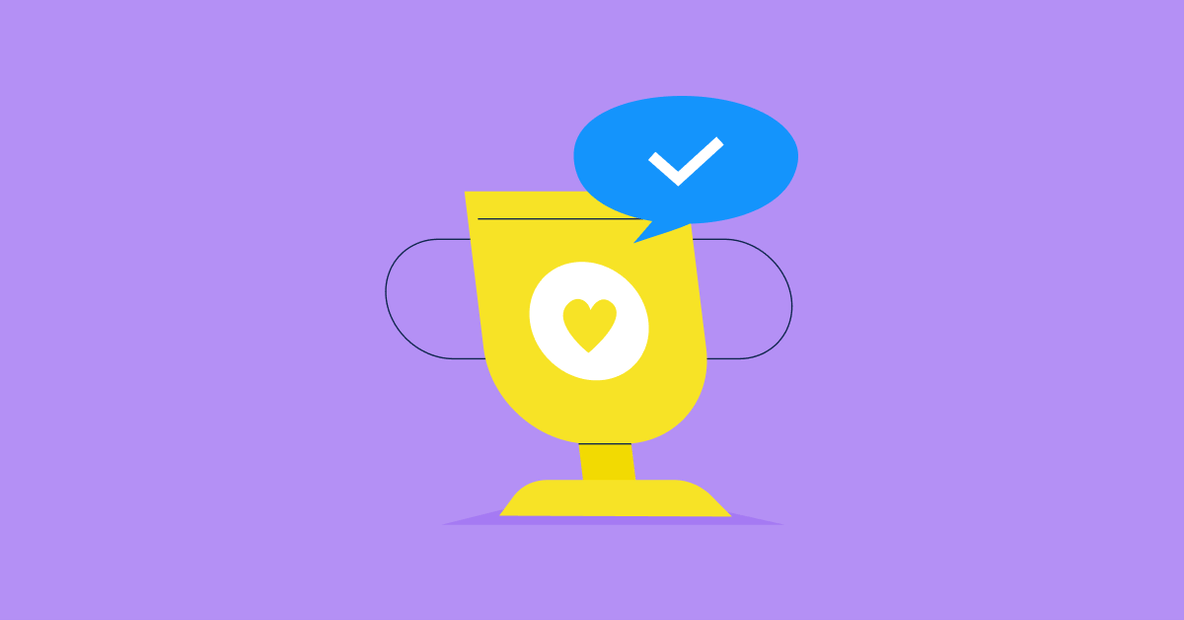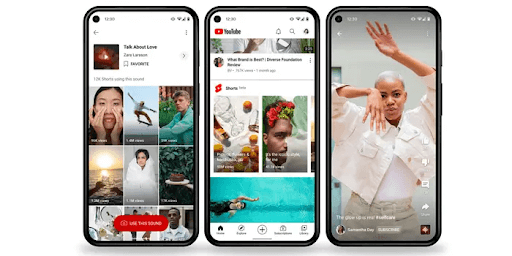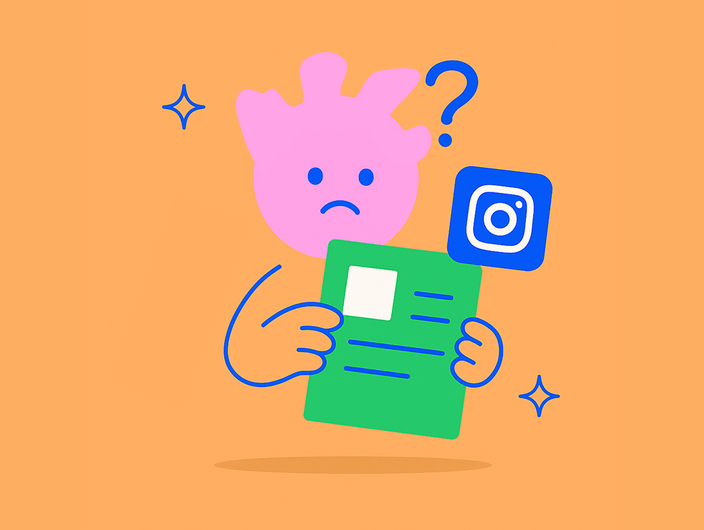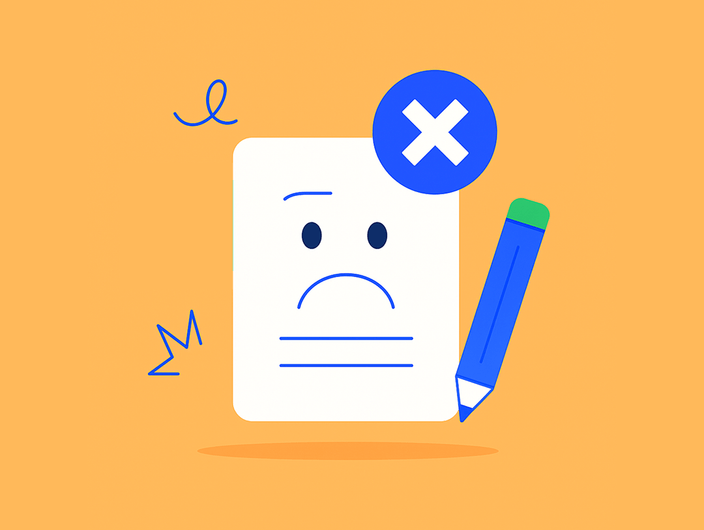Social media marketing campaigns this year have been a mashup of social, tech, and pop culture. Some ads raised awareness, while others challenged injustices or simply tried to make us laugh.
As 2021 is slowly coming to an end, we’re bringing you our favorite and most memorable social media marketing campaigns of the year.
1. Dove – #NoDigitalDistortion
It’s not the first time that Dove has highlighted an increasingly difficult problem nowadays – the widespread use of digital distortion in online images.
Use of such filters is a leading cause of eating disorders, body dysmorphia, and even depression for young people today. The use of filters to distort images is especially popular on Instagram, where they are commonly used in people’s Stories to “slightly” improve their appearance.
Dove draws attention to the fact that 80% of girls had already applied a filter or used a retouching app to change the way they look in their photos by age 13. They get so used to their appearance with the use of filters that they cannot publish Stories without them, and may eventually stop accepting themselves as they are.
The #NoDigitalDistortion social media campaign aims to stop girls from harming their self-esteem by retouching. Dove’s short video, “Reverse Selfie,” highlighted the issue and quickly went viral, sparking heated discussions on social media channels.
As part of this social media campaign, users could make the #NoDigitalDistortion Pledge and publish selfies without any adjustments, which helped raise awareness of the problem. What’s more, Dove provided parents, carers, and young people with a toolkit to help them all navigate social media more positively.
Lesson learned:
Dove’s social media marketing campaign is an example of a carefully organized strategy: from appealing content that started everything to downloadable toolkits that teachers and parents could use to raise awareness of the problem. Dove engaged their audience significantly by encouraging social media users to include the hashtag #NoDigitalDistortion, giving their campaign publicity and producing a lot of user generated content (UGC).
2. Tiffany & Co. – About Love
If we just mention two names, Beyoncé and JAY-Z, then you already know the campaign results, don’t you?
This was the first campaign in which the couple appeared together – a result of close collaboration and a shared vision between both the Carters and Tiffany & Co. In the campaign film, the couple is portrayed in intimate moments that capture their unique love.
It could be said that the entire campaign is a feast for the senses, especially with Beyoncé singing “Moon River” in the background.
“As a brand that has always stood for love, strength, and self-expression, we could not think of a more iconic couple that better represents Tiffany’s values.” – said Alexandre Arnault, Executive Vice President of Product & Communications.
Lesson learned:
For years Tiffany & Co. has represented the same values, which are constantly transferred to its advertising – and it pays off. Even though this campaign probably wasn’t aimed at social media specifically, Tiffany & Co. took full advantage of the fact that Beyoncé’s posts can reach a vast audience (she has 213M followers on Instagram). A series of posts on the brand’s social media, as well as on Beyoncé and JAY-Z’s profiles, successfully promoted the campaign.
3. YouTube – ‘The Shorter Side of YouTube’
The new Shorts feature on YouTube was released along with short videos published on YouTube’s social media channels and an exclusive collaboration with the K-pop band BTS.
BTS’ announcement Tweet has attracted nearly a quarter of a million likes. The group’s official account, @BTS_twt, has an influencer score of 94, making them one of the most influential accounts on Twitter. The collaboration generated over 148,000 video submissions across 84,000 channels.
Lesson learned:
YouTube knew precisely how to reach its target group since most of the band’s listeners are Gen Zers who love creating short videos. Just take a look at TikTok, which is a Gen Z platform. By collaborating with BTS, YouTube created a social campaign that captured the attention of a global audience.
4. McDonald’s – #McSpicyDebate
McDonald’s launched a unique campaign to promote and celebrate their new McSpicy burger, asking “how spicy is it?”
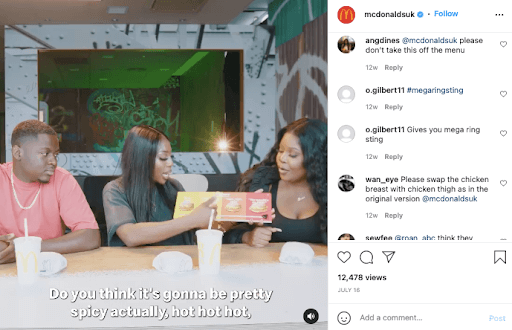
During the promotion, social media users on every platform were asked to join the #McSpicyDebate and tell the brand about the level of spice of their new burger. McDonald’s customers were asked to rate the McSpicy burger according to one of four categories: ‘a lil kick’, ‘pretty spicy actually’, ‘hot hot hot’, or ‘my mouth is on fire!‘.
McDonald’s UK social media accounts all featured short videos as the main content of this campaign. The four influencers: Bash The Entertainer, Nella Rose, Adeola Patronne, and Ehiz Ufuah, all judged the level of spiciness of the new burger and encouraged people to take part in the debate.
Lesson learned:
To help the audience identify with their own spice tribe, McSpicy also offered a custom Snapchat lens, emoji, and GIF. Simple, yet it still successfully encouraged people to share their opinions and motivated their friends to do the same.
5. NHS England x YouTube – national icons promote vaccines
The year has been all about vaccinations, so it’s no wonder that many campaigns have been running to encourage people to get jabbed. In our opinion, NHS England provided the most interesting perspective on what is definitely the most critical topic of the decade, if not the century.
In February, they launched a video that was targeted towards older generations and those in high-priority groups. A spoof audition tape video was produced featuring Elton John and Michael Caine.
And that’s not all. Later on, in May, YouTube launched the next NHS campaign titled ‘Let’s Not Go Back.’ The campaign was targeted at millennials, including 12 short video ads and broader out-of-home variations to remind young people about the importance of receiving the vaccine.
Furthermore, YouTube recruited its most influential users, such as lifestyle guru Leena Normington and football blogger Robbie Lyle, to spread the message and dispel vaccination myths.
Lesson learned:
The campaign hit home, and the vaccination drive continued rapidly in the months that followed. Fun, but with a serious message. Possible? Yes, as this example shows.
6. Weetabix and Heinz – just one Tweet
Cereal brand Weetabix posted the following recipe, suggesting Heinz beans as a topping for “breakfast with a twist.” The reaction was shocking. Among the many replies were official brand accounts and people who tried this “miracle” dish. The tweet gained thousands of likes and reactions. Bon appetit!
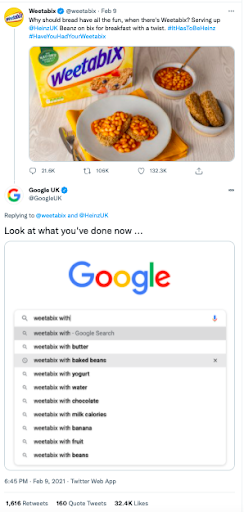
Lesson learned:
Intense, shocking information is a favorite of the Internet. We can make that claim just after seeing what resulted from this one “innocent” tweet. Weetabix knows how to get attention.
7. Super Bowl – Bud Light Legends
Super Bowl commercial breaks always arouse a lot of emotion, and it was no different this year. One of them that was rolled out on social media received more than 260,000 views on Instagram and thousands of likes on Twitter. It also generated a wide range of UGC and was shared by numerous celebrities.
What are we discussing? The Bud Light Legends who have come back to save the day for the Super Bowl, as they do every year. Together, they helped a courier who had inadvertently overturned his truck, dropping cans of the beverage everywhere and delaying their delivery.
Lesson learned:
The brand gathered a group of their fans who were super excited to see the Bud Light Legends return, and it managed to create a buzz on Twitter as soon as the campaign went live. It’s fair to say that the Bud Light commercial for the Super Bowl in 2021 was their strongest one yet, and it definitely raised the bar for future campaigns.
8. Airheads – Skip Ad
Airheads launched a funny skip ad campaign with three videos: Construction, Mannequin, and Chainsaw. They all start with the words “I think we’re in an Airheads commercial, skip it.” After each actor clicked on the skip button, a plot twist played out.
The one featuring a man chasing a woman with a chainsaw was the most successful. When the man clicked the skip ad button, some funny music began to play, and this image appeared.
The commercials end with the words: “With Airheads, you can’t not play, even in a skip ad.“
Lesson learned:
A creative way of making a skip ad not skippable. Such ads can still be funny and encourage people to watch until the end.
9. TikTok – Entertainment. Now on TikTok
TikTok launched a TV and digital campaign fronted by the hosts of the show “Ant & Dec’s Saturday Night Takeaway” and created by Mother.
A 60-second spot takes the viewer on a brief history of entertainment. The TV commercial was accompanied by shorter 20-second versions, social media assets, and in-app activity on TikTok.
Lesson learned:
This commercial shows that TikTok is just another way to pass the time and have fun, as there have been many other different ways before. It’s an excellent way to demonstrate to people who don’t understand the phenomenon of this app and its growing role in popular culture. Entertainment has moved to TikTok now.
10. Spotify – #FindYourFeels
‘Find Your Feels’ is Spotify’s multichannel influencer campaign designed to “empower Gen Z to express themselves.” In this campaign, Spotify celebrates the positive influences music has on people and its role in their journey to find their rhythm in life.
Spotify’s campaign involves role models sharing their stories and the songs that remind them of inspiring times, are motivational, or guide them through important moments. The campaign was run across influencer and Spotify social accounts and through paid social media channels, TikTok and YouTube.
Lesson learned:
We can definitely learn a lot from Spotify about marketing. Just take a look at their brilliant idea of an annual summary of what you have listened to, which can be shared on social media. At the beginning of the year, there is always a big buzz around it.
It was an excellent idea to use several well-known influencers, including disability activist Lucy Edwards, trans model Kenny Ethan-Jones, footballer Callum Hudson-Odoi, and TV personality Molly-Mae Hague.
11. American Eagle & Snapchat – Back-to-School
With the help of influencers and actors, American Eagle created a virtual try-on experience for the back-to-school season. To further appeal to the Gen Z audience, the retailer also gave consumers the chance to personalize their Bitmoji with AE clothing.
This was the third collaboration between AE and Snapchat after the winter holiday experience generated $2 million in revenue, and first-quarter sales reached $1 billion.
Lesson learned:
Millennials and Gen Z are expected to increase their buying power, so brands need to embrace the social platforms and features that appeal most to them. We must admit that American Eagle did a great job putting together an exciting idea and building a lasting connection with a generation of young buyers.
12. Team GB and TikTok – #AskTeamGB
It was an unusual Olympic season, with headlines often dominated by Covid instead of athletes’ performances. The British team and TikTok, however, dealt with these challenges well.
On their official account, TikTokers could ask questions directly to Team GB with the possibility of receiving direct responses from athletes. With over 60 million views of the #AskTeamGB hashtag, there can be no doubt that TikTok and TeamGB pulled off a clever move to reach new audiences.
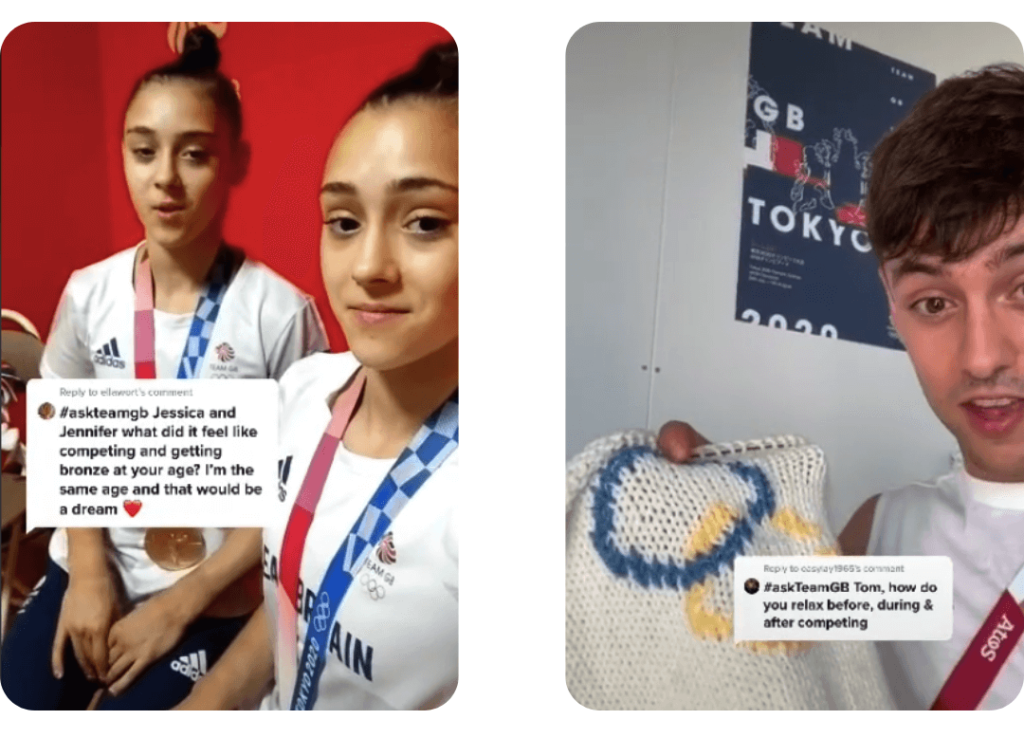
Lesson learned:
Team GB built up a nice relationship with fans and showed how to engage audiences in a slightly different way to normal, using current trends.
13. Pandora – #PandoraME
With the relaunch of the Pandora ME collection, the jewelry giant launched a digital campaign targeting a new audience of Gen Z shoppers.
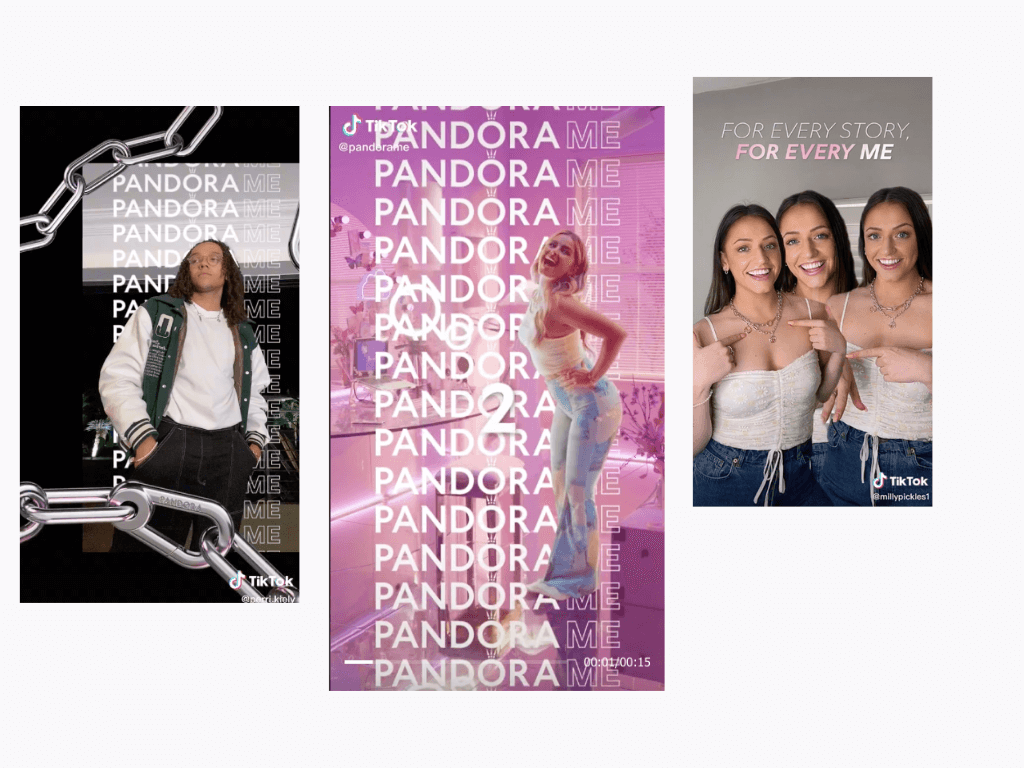
The campaign included several engaging videos, reels, and GIFs on Instagram, in-store imagery, plus the Animal Crossing Pandora Island available in-game. In addition to all this, Pandora created a #123PandoraMe challenge on TikTok, in which users were asked to share three different sides of themselves based on the company’s tagline, “For Every Me.”
Lesson learned:
It was an outstanding campaign explicitly targeted to a younger demographic. The hashtag #123PandoraME has been watched almost 10 billion times! So TikTok trends work, and it’s worth using them to reach a huge number of new recipients.
14. Cadbury – Worldwide Hide
During full lockdown restrictions in the UK, Cadbury encouraged its fans to hide a virtual Easter egg anywhere in the World via Google Maps Street View and then post a personalized clue for the recipient as to where it could be hidden. Almost 700,000 eggs were hidden as a result.
Lesson learned:
The content created by Cadbury included short looping GIFs, engaging Instagram Stories, partnerships with influencers, and UGC featuring the most popular hiding spots. It was a well-planned campaign involving all integrated channels and very coherent actions that effectively impacted the recipients.
15. Tesco – Pop to your local if you can
Tesco tweeted this unexpected message in April, showing their support for local businesses that were facing huge losses from the lockdown. The brand gained an overwhelmingly positive response from users and received 32.8k likes and over 4k retweets.
Lesson learned:
With this thoughtful statement, the brand showed itself in a positive light and proved that they are not indifferent to the fate of others. This approach is worth following.
16. Slido – Meeting Zombies
Slido, the audience interaction platform for meetings, addresses the issue of online meetings that often turn into zombies when nobody listens or asks questions. Everybody is doing something other than actively participating in such meetings.
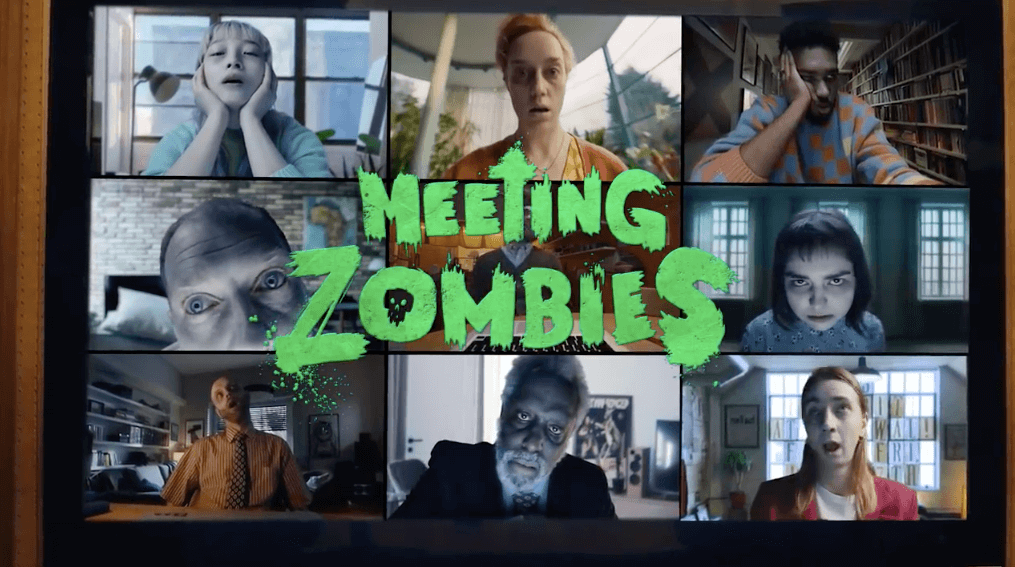
Lesson learned:
The increasing amount of remote work actually makes us overwhelmed with online meetings, and Slido found a fun way to show us how to “make your meetings come alive.” This unconventional ad by Triad Advertising is appealing, funny, and something that most people can identify with.
17. The Body Shop – #SelfLoveUprising
#SelfLoveUprising, the Body Shop campaign, provided plenty of advice to help its followers and customers start their self-love journeys. Various activists explained what self-love means to them and how it has helped them grow as people.
Lesson learned:
The brand decided to raise a very important topic using TikTok and short videos, and they delivered great results (the most popular video gained 18.5 million views). This is an example of the main campaign theme that is in line with the brand and its vision.
18. Mental Health Foundation – #MentalHealthAwarenessWeek
This year, the Mental Health Foundation launched a campaign to promote the mental health benefits of connecting with nature. The charity shared a number of interesting illustrated statistics from a recent survey, as well as tips and tricks for making the most of the natural surroundings.
Lesson learned:
To accompany its social media efforts, the Mental Health Foundation also released a short series of podcasts. The popularity of podcasts continues to grow, so it’s worth considering this form of content in your own future online marketing campaigns.
19. Pringles – Step Up The Spice
This Pringles campaign was created to promote three new flavors of the popular snack. During this campaign, consumers were challenged to move up the spiciness scale and test their taste buds with the question “which can you handle?.”
A brand-first Snapchat augmented reality (AR) filter brought the viral ‘Floor is Lava’ game to life for Pringles fans, the goal of which was to reach a Pringles can without touching the ground.
Lesson learned:
Despite its infancy, AR is predicted to grow in the coming year. That’s why it was a good move by Pringles to use this technology in its latest campaign.
20. Best RTM brands’ reactions – #Facebookisdown
This is a topic that could not have been missed by anyone who has at least one social media account. At the beginning of October, Facebook, WhatsApp, and Instagram all went down at the same time around the World. This was definitely one of the most remarkable events on social media this year.
Many brands took advantage of the situation and quickly reacted to the fact that some of the most important social media apps weren’t working. These are our favorites:
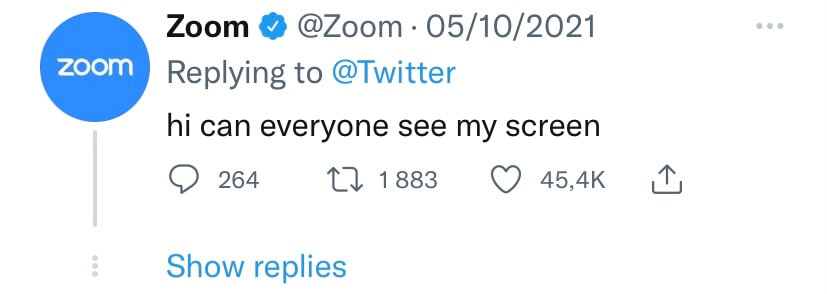
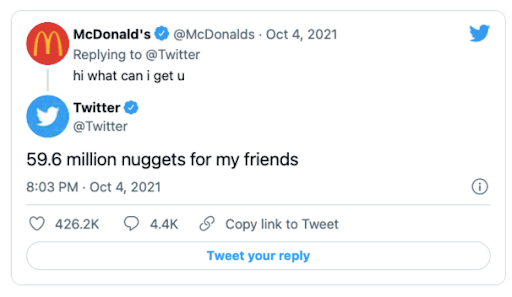
Lesson learned:
Real-time marketing is very effective (people like it, share it, and engage with it), but it is challenging. You have no time to prepare, and you need to act quickly before your competitors do. Nevertheless, these examples prove that real-time marketing is worthwhile, so remember about it in 2022.
21. IKEA – Fortune Favours the Frugal
Lastly, let’s look at the IKEA campaign that took place on January 1st. It focused on two primary goals, reducing their environmental impact and keeping prices low.
In a campaign that used TV, social, and digital media, Ikea presented a giant ball of litter hurtling towards Earth. They then showcased various eco-friendly products that the furniture store offers, all contributing to decreasing the size of the ball of litter.
Lesson learned:
Clips from everyday life contrasted with shots of vast space, showing how even small changes can have a huge impact on the environment. This made for an effective and encouraging campaign that was thought-provoking and with a powerful message, which is why we like it.
What social media marketing campaigns will the new year bring?
It’s clear that social media marketing campaigns will be expected to be short, simple, creative, and above all else shareable in the coming year. So what campaigns can we expect to see from next January? 2022, we’re already excited.
